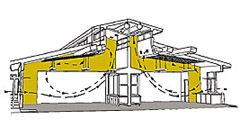High performance does not necessarily mean high-tech, a point illustrated by the $7-million, 42,000-sq-ft Newport Coast Elementary School, which opened in March 2001.
Overlooking Newport Harbor, the school uses daylighting and natural ventilation strategies to take advantage of the Southern California climate. "There is nothing outrageous [about this project]. It is just sensible design," says Kerry Parker, senior associate at mechanical engineer TMAD Inc., Ontario, Calif.
The campus has gable-roofed, wood-framed structures clustered around courtyards and two types of classrooms. Linear classrooms have operable windows on the east and west, allowing natural lighting from two sides and cross ventilation. Back-to-back classrooms share a wall that runs under the roof ridge, and have either north or south-facing operable windows.
 |
| HELPING HAND Fans draw air through classroom window. (Photo courtesy of Perkins & Will) |
In this second type, clerestory windows bring light into north-facing classrooms. Because these rooms do not have cross-ventilation, exhaust ducts are located in the roof substructure to pull fresh air through the operable windows.
Light shelves at windows reduce solar gain and reflect sun off ceilings into classrooms. To distribute the light, the designers used a different ceiling configuration for each classroom type, but opted for a single light shelf profile throughout the project. "The light shelves are most effective on the south, but they are wide enough for any orientation," says Ryan Hollien, an associate in the Santa Monica office of architect Perkins & Will.
The daylighting and natural ventilation strategies, together with other features, like occupancy sensors and multiple switching, should result in a 43% utility savings over a school that minimally complies with California's energy code, say designers.
Southern California Edison, the local utitlity, provided engineering support during the design process and now is monitoring temperature variation inside classrooms and ambient weather conditions. The process will be completed next month. In the fall, SCE will use this data at a faculty orientation intended to help teachers take advantage of the energy-saving features. According to Tony Pierce, SCE's project manager: "Though these systems seem intuitive, some faculty members will default to the thermostat for comfort control."

Post a comment to this article
Report Abusive Comment